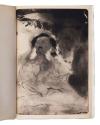Quinze histoires d’Edgar Poë
Artist: Louis Auguste Mathieu Legrand (French, 1863-1951)
Author: Edgar Allan Poe (American, 1809-1849)
Author: Charles Baudelaire (translator) (French, 1821-1867)
Publisher: Chamerot et Renouard (for the Société des Amis des Livres), Paris, 1897
Printer: aquatints: MM. Porcabeuf, Paris; decorations and text: Chamerot et Renouard, Paris, reproductions from line cuts made by MM. Duco
Date: 1897
Dimensions:
Book: H: 11 in. (280 mm); W: 7 5/8 in. (194 mm); Depth: 1 7/16 in. (37 mm).
Page (untrimmed): H: 10 3/4 in. (273 mm); W: 7 3/8 in. (188 mm).
Medium: Original prints: 30 aquatints on ivory wove paper (2 states each of 15 plates).
Reproductions: 17 line block reproductions of drawings, and 16 photolithographs of drawings, incl. the wrappers.
Text: letterpress.
Paper: Marais cream wove paper watermarked with the monogram device of the Société des Amis des Livres.
Classification: Books
Credit Line: Gift of Molly and Walter Bareiss
Object number: 1984.674
Label Text:Louis Legrand, Quinze histoires d’Edgar Poë (Fifteen Stories by Edgar [Allan] Poe).
Text by Edgar Allan Poe (1897)
Louis Legrand was commissioned to illustrate a selection of Poe’s short stories by the Société des Amis des Livres (The Society of the Friends of Books), a Parisian book-collecting society. Legrand’s usual subject matter involved Parisian nightlife: cafés, prostitutes, dancers, and dandies. It was, therefore, with some reluctance that Legrand undertook the aquatints for Poe’s dark and mysterious writings, translated into French by poet Charles Baudelaire.
However, Legrand had learned etching in 1885 from Belgian artist Félicien Rops, who was famous for his erotic, macabre, and even perverse imagery. Legrand had adopted a tendency towards some of these qualities in his own work, which he drew on in creating images for Poe’s text.
One of the openings displayed is from the gruesome gothic story Berenice (1835), in which a disturbed young man performs some postmortem dental surgery. The other opening is from the humorous and satirical Some Words with a Mummy (Petite discussion avec une momie) (1850). Here an ancient Egyptian (named Allamistakeo) comes back to life to berate the group of scientists and amateurs preparing to dissect him. The story cleverly deflates some assertions of “Yankee ingenuity” and the assumption of the superiority of modern life in the Industrial Age.
Text by Edgar Allan Poe (1897)
Louis Legrand was commissioned to illustrate a selection of Poe’s short stories by the Société des Amis des Livres (The Society of the Friends of Books), a Parisian book-collecting society. Legrand’s usual subject matter involved Parisian nightlife: cafés, prostitutes, dancers, and dandies. It was, therefore, with some reluctance that Legrand undertook the aquatints for Poe’s dark and mysterious writings, translated into French by poet Charles Baudelaire.
However, Legrand had learned etching in 1885 from Belgian artist Félicien Rops, who was famous for his erotic, macabre, and even perverse imagery. Legrand had adopted a tendency towards some of these qualities in his own work, which he drew on in creating images for Poe’s text.
One of the openings displayed is from the gruesome gothic story Berenice (1835), in which a disturbed young man performs some postmortem dental surgery. The other opening is from the humorous and satirical Some Words with a Mummy (Petite discussion avec une momie) (1850). Here an ancient Egyptian (named Allamistakeo) comes back to life to berate the group of scientists and amateurs preparing to dissect him. The story cleverly deflates some assertions of “Yankee ingenuity” and the assumption of the superiority of modern life in the Industrial Age.
Not on view
In Collection(s)


































